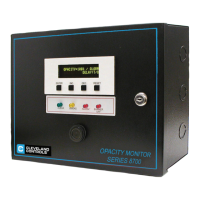• OPACITY MONITOR MANUAL IM-A-08740-05 • 7
1.0 INTRODUCTION
1.1 Description of Operation
The Cleveland Controls Model A-08740 Universal Opacity Monitor provides reliable, continuous measurement
of the density of conned particulates such as dust or smoke. It is easy to calibrate and requires no routine
maintenance other than occasionally cleaning the sight glass.
The basic system consists of an electronics unit and two breeching components, consisting of an LED
light source that directs a beam through the measured particulate, and a light sensor that receives the beam,
detects changes in opacity, and sends a proportional signal to the electronics unit. The wide-beam light source
and narrow-view receiver make installation easy because alignment of the breeching units does not need to be
precise.The electronics produces a digital readout of percent opacity and a 4-20 mA DC output signal suitable
for recording, display, or indication. SPDT contacts are provided for a remote alarm (which can be purchased
separately: Cleveland Controls L-05500-00). The operator can select manual or automatic alarm reset. Modbus
communications for interface with a SCADA system (Supervisory Control and Data Acquisition system) or other
controls is standard. A standard serial printer port is provided. The electronics unit is available in open-mount,
surface-mount, and flush-mount formats. It can be installed in any dry, convenient area within 250 feet of the
light source and receiver units. The standard model has a vacuum fluorescent display with three status LED’s.
There are four LED indicators on units equipped with auxiliary functions (described below).
The Burner Cutoff Auxiliary Function is a delayed-off timer that shuts the burner down if an alarm
condition (opacity exceeding 20%) persists for 120 seconds. The timer can be reset manually only after
reduction of opacity: it cannot be reset when opacity is above 20%. (This feature meets the requirements of
the New York City air pollution control code for alarm and burner control functions). Model A-08740 Opacity
Monitors equipped with the burner cutoff function have four LED indicators on the front of the electronics panel,
marked Clear, Smoke, Alarm, and Burner Off. In addition, an audible alarm with adjustable trip point and delay is
mounted on the front face of the electronics unit.
The Overre Air Timer Auxiliary Function is a delayed-off timer that provides relay contacts for the control
of smoke-reduction air in coal-red installations. As soon as opacity exceeds the alarm trip point, the relay is
energized. It remains energized as long as the alarm condition persists. After the alarm condition is corrected,
the relay remains energized for an adjustable period up to ve minutes. Model A-08740 Opacity Monitors
equipped with the overre air timer function have four LED indicators on the front of the electronics panel,
marked Clear, Smoke, Alarm, and Overre Air.
Please Note:
• The Cleveland Controls Model A-08740 Universal Opacity Monitor as shipped includes the electronics
unit, light source, receiver, and two sight glass assemblies that must be mounted in the duct.
• The traverse and mounting pipe, plus any required purge connections and/or air supplies, are to be
provided by the installing contractor.
P/N 31726 Purge Air Blower Kit for positive pressure flue gas pressure:
Purge air is recommended if the flue duct is held at positive pressure.
Sight glass lenses on the ends of the traverse pipe will become cloudy
when the flue gas pressure is greater than the ambient air pressure,
because water from the flue gas condenses on the lenses. This results
in false opacity alarms. The lenses can be purged with instrument air (not
plant air) if sufcient volume is available, but usually it is not. The solu-
tion is a blower to provide ambient air at low pressure (not compressed)
that will not condense water on the lenses. A single blower, wired to run
whenever the burner is running, can be connected to ttings near the
lenses. Cleveland Controls P/N 31726 Purge Air Blower Kit operates
with 120/230 V ac, and includes a blower with air inlet lter, four ttings,
and two 6-ft lengths of 1-inch liquid-tight flexible conduit used for tubing
connections to the traverse pipe near both the light source and receiver
lens.

